CPS Unit Number 032-01
Camp: 32
Unit ID: 1
Operating agency: AFSC
Opened: 5 1942
Closed: 11 1943
Workers
Total number of workers who worked in this camp: 350
-
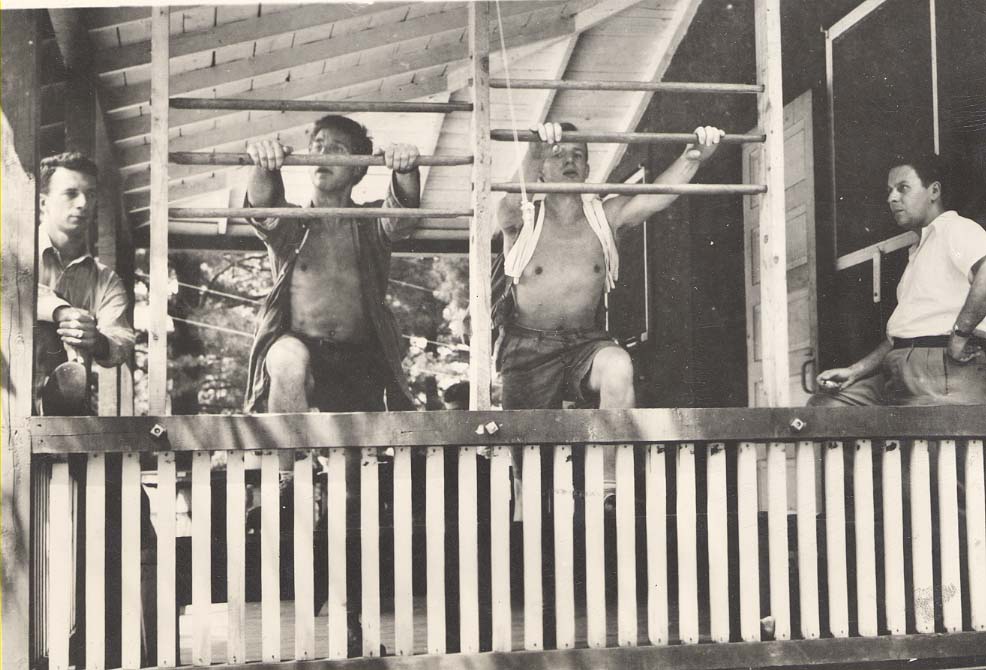 CPS Camp # 32, West Campton, New HampshireGuinea Pigs John Steer and Christopher Cadbury working out in summer 1943. "The CPS protein and vitamin diet experiment, undertaken by the Harvard Fatigue Laboratory, sponsored by the National Research Council."Digital Image from American Friends Service Committee: Civilian Public Service Records (DG002), Swarthmore College Peace Collection, Swarthmore, Pennsylvania1943
CPS Camp # 32, West Campton, New HampshireGuinea Pigs John Steer and Christopher Cadbury working out in summer 1943. "The CPS protein and vitamin diet experiment, undertaken by the Harvard Fatigue Laboratory, sponsored by the National Research Council."Digital Image from American Friends Service Committee: Civilian Public Service Records (DG002), Swarthmore College Peace Collection, Swarthmore, Pennsylvania1943 -
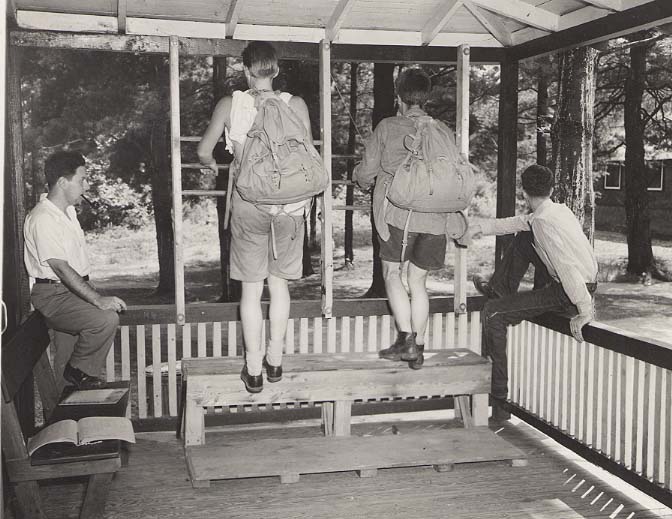 CPS Camp # 32, West Campton, New Hampshire, Guinea pigs 2John Steer and Chris Cadbury working out. "The pack test, given to 'guinea pigs' in the CPS protein and vitamin diet experiment held at CPS Camp #32, West Campton, NH, during the summer of 1943. This experiment was undertaken by the Harvard Fatigue Laboratory sponsored by the National Research Council."Digital Image from American Friends Service Committee: Civilian Public Service Records (DG002), Swarthmore College Peace Collection, Swarthmore, Pennsylvania1943
CPS Camp # 32, West Campton, New Hampshire, Guinea pigs 2John Steer and Chris Cadbury working out. "The pack test, given to 'guinea pigs' in the CPS protein and vitamin diet experiment held at CPS Camp #32, West Campton, NH, during the summer of 1943. This experiment was undertaken by the Harvard Fatigue Laboratory sponsored by the National Research Council."Digital Image from American Friends Service Committee: Civilian Public Service Records (DG002), Swarthmore College Peace Collection, Swarthmore, Pennsylvania1943 -
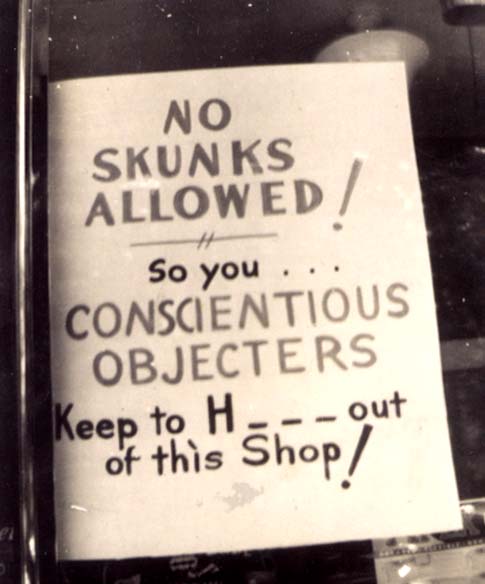 CPS Camp # 32, West Campton, New Hampshire. No Skunks Allowed.This sign appeared (1942-1943) in a Plymouth NH barbershop for awhile, until public opinion forced the proprietor to remove it. The final fling was 'Are We Germans? Can't we tolerate anything other than ourselves?' It worked and the CO's weren't the ones to say it.Digital Image from American Friends Service Committee: Civilian Public Service Records (DG002), Swarthmore College Peace Collection, Swarthmore, Pennsylvania1942-1943
CPS Camp # 32, West Campton, New Hampshire. No Skunks Allowed.This sign appeared (1942-1943) in a Plymouth NH barbershop for awhile, until public opinion forced the proprietor to remove it. The final fling was 'Are We Germans? Can't we tolerate anything other than ourselves?' It worked and the CO's weren't the ones to say it.Digital Image from American Friends Service Committee: Civilian Public Service Records (DG002), Swarthmore College Peace Collection, Swarthmore, Pennsylvania1942-1943 -
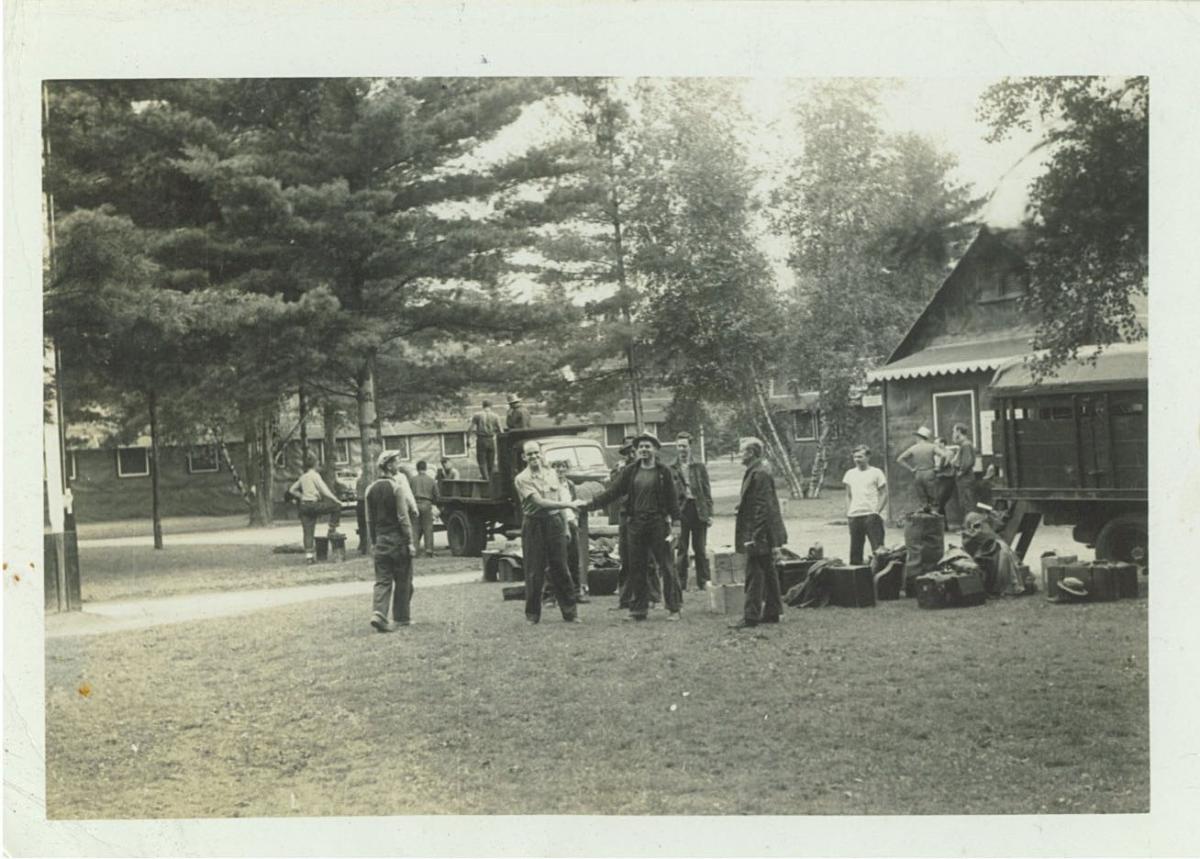 CPS Camp # 32, West Campton, New HampshireLeaving for Lyceum from base camp.Carhart's "High Hat" Panel Art Prints. Digital image from the Quentin Stodala Papers in Civilian Public Service: Personal Papers & Miscellaneous Material (DG 056), Swarthmore College Peace Collection, Swarthmore, PennsylvaniaSept. 16, 1942
CPS Camp # 32, West Campton, New HampshireLeaving for Lyceum from base camp.Carhart's "High Hat" Panel Art Prints. Digital image from the Quentin Stodala Papers in Civilian Public Service: Personal Papers & Miscellaneous Material (DG 056), Swarthmore College Peace Collection, Swarthmore, PennsylvaniaSept. 16, 1942 -
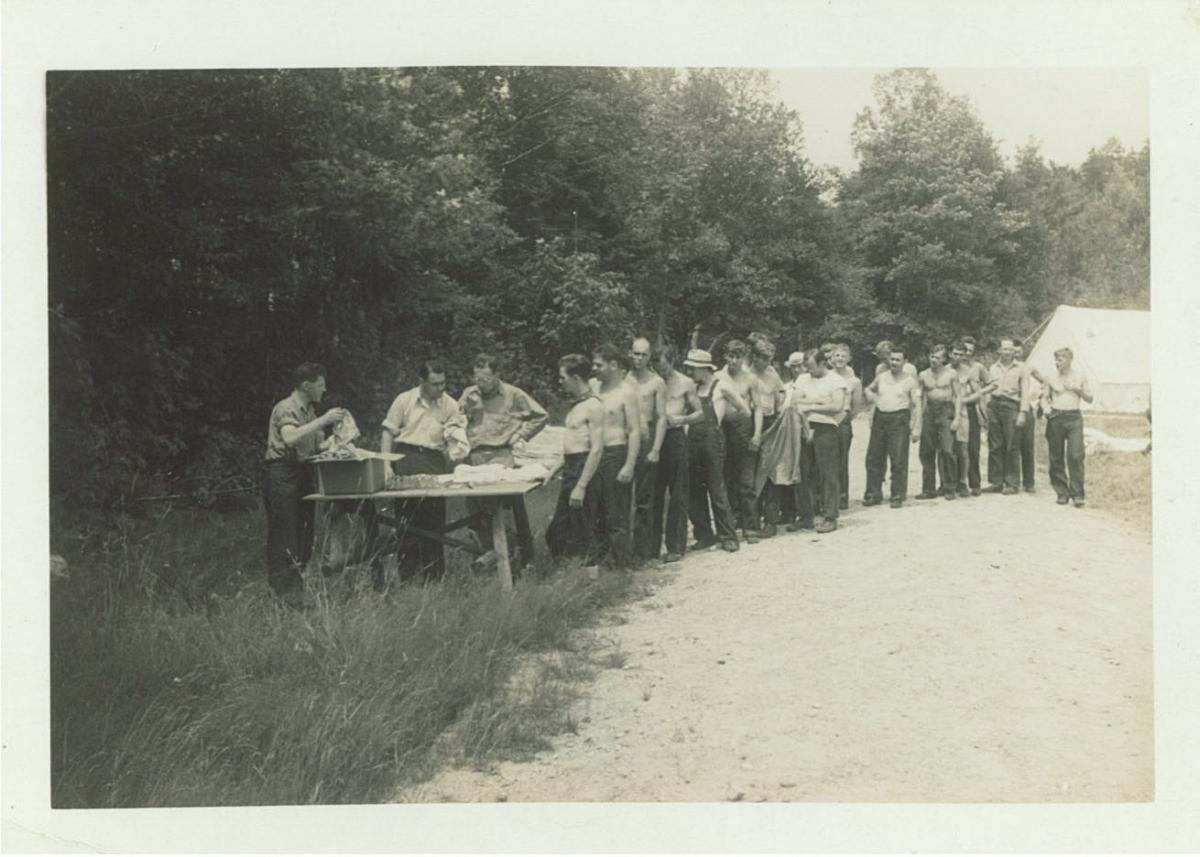 CPS Camp # 32, West Campton, New HampshireGetting our lousy underwear at the Lyceum.Carhart's "High Hat" Panel Art Prints. Digital image from Quentin Stodala Papers in Civilian Public Service: Personal Papers & Miscellaneous Material (DG 056), Swarthmore College Peace Collection, Swarthmore, PennsylvaniaSept. 16, 1942
CPS Camp # 32, West Campton, New HampshireGetting our lousy underwear at the Lyceum.Carhart's "High Hat" Panel Art Prints. Digital image from Quentin Stodala Papers in Civilian Public Service: Personal Papers & Miscellaneous Material (DG 056), Swarthmore College Peace Collection, Swarthmore, PennsylvaniaSept. 16, 1942
-
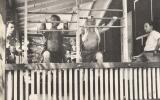 1943
1943 -
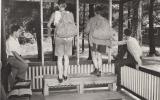 1943
1943 -
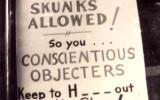 1942-1943
1942-1943 -
 Sept. 16, 1942
Sept. 16, 1942 -
 Sept. 16, 1942
Sept. 16, 1942
CPS Camp No. 32, a Forest Service base camp located in West Campton, New Hampshire and operated by the American Friends Service Committee, opened in March 1942 and closed in November 1943. The men fought fires, and performed preventive and preparatory work.
CPS Camp No. 32, a Forest Service base camp, was located in West Campton, New Hampshire in Blair State Forest and Livermore Falls State Forest. In Grafton County, the camp was operated by the American Friends Service Committee.
Directors: Kenneth Morgan, James Mullin, Don Stephenson
One fourth of the men had transferred in from CPS camp No. 53 at Gorham, New Hampshire in May, 1943.
Men at American Friends Service Committee camps tended to constitute the most religiously diverse group of men, including men who reported no religious affiliation at the time they entered CPS. Those who declared Friends as their religious affiliation found themselves in the minority. That was the case at West Campton.
Forty-three percent of men in Friends camps reported technical and professional occupations when they entered CPS.
Men in Friends camps reported the highest level of education upon entry into CPS having completed an average of 14.27 years of education, including sixty-eight percent who had completed one or more years of college, graduate and post graduate work. (Sibley and Jacob pp. 171-72)
Men primarily fought fires, although they also cut wood for use at the camp and in the community. In addition they conducted fire prevention activities and prepared the forest and equipment to improve fire fighting ability. In the eastern forest service camps, men cleared debris left over from the 1937 hurricane.
Some of the men in the camp acted as guinea pigs in the protein and vitamin experiment directed by the Harvard Fatigue Laboratory. Others applied for detached service in mental hospitals.
Active in publishing, the men reported the CPS struggles over what constituted “work of national importance”, work without pay, problems of non-cooperation, and gave voice to those who held alternative views of the best way to communicate the pacifist way of life. George H. Baird, in a letter to Paul French wrote, “They want to show that the Pacifist is the normal man, doing a normal job, receiving a normal wage, and living naturally and normally among people.” (“Motivation of ‘Non-Peace Church’ Pacifists Outlined by Baird” in Action [April 19, 1943] p. 2)
The men published a camp paper called The Alarmist to provide distractions to campers who found little meaning in the boring and repetitive nature of the work. “The Alarmist is conceived, therefore as an instrument of distraction. It proposes, through libelous and pernicious expression, to aid in discovering the safest means of escape”. (January 1943 p. 2)
They also published three issues of The Compass in November 1942, February 1943, and a spring 1943 issue. A periodical with the same title was also published at CPS Camp No. 21 at Cascade Locks, at CPS Camp No. 56 at Waldport, and at CPS unit No. 104 at Ames, Iowa.
They published The Bulletin, from December 1942 through September 1943. The February 11, 1943 issue featured “The Mental Hospital: A Debate”, with Walt Taylor asking “Are We Traitors to CPS?”
“Detached Service” in my opinion is a misnomer. Men going on detached service are blind or insincere if they go with the idea that they are becoming detached from conscription, the CPS program or CPS problems. I regard special projects as a part of the CPS program, and therefore I feel that no one is justified in going to a mental hospital to wash his hands of the camp and its problems . . . .
Gerry Dingman replied that while it appears to offer work of national importance, it only complicates the situation of the CO, “. . . definitely gives the color of volunteerism to his position. . ..” (p. 1)
Page two of the same issue included a listing of staff and a featured statement.
SERVING TWO MASTERS
The controversy between the Service Committee and Selective Service which held up approval of our men for the Brattleboro Hospital Unit several days, sharpens an issue worth noting. Dave Swift in a letter to Carlton Mabee says: “I have been much disturbed by rumors scattered by Selective Service officials that hospital units are directly under the government, and also by the orders setting up hospitals signed by Hershey indicating that ‘administrative and direct control is through Camp Operations Division of Selective Service.’ If these statements are true, then we’ll be frozen in hospitals . . . I feel that it is very important that this be straightened out before these new units are opened up, or else that the men be fully informed that they are entering a unit which may be more under government control than the camps.”
Finally, they actively participated in the publication of Action: a Journal of CPS Opinion, sponsored by the Northern New England Regional Council, a joint effort of Forest Service camps at West Campton, and Gorham in New Hampshire, Oakland, Maryland, and guinea pig units at Massachusetts General Hospital. The editorial board at West Campton consisted of Editor Gerald Dingman, Managing Editor William Kreibel, Business Manager Robert Vogel (March 24 issue) and Hal Palmer (April 19 issue), and Production Staff members Chris Cadbury, Maurice Friedman, and Gregory Lindes. An Advisory Board included Winston Bailey and Ernest Herbster from CPS No. 53 at Gorham, New Hampshire; Matthew Gold at Massachusetts General Hospital CPS No. 115 units; Fred Mabee, Robert Ludlow and Watson (first name not identified) from CPS No. 89 at Oakland, Maryland.
The journal, published March through June, 1943, in an editorial by Henry George, stated its purpose.
The job of ACTION is to make CPS thinking known to CPS. To do that effectively, it must be done frequently. Ideas must be circulated while they are still alive and capable of stimulating action—hence a weekly publication. It must be done fairly and without bias in any direction—hence our editorial policy: “The greatest latitude of expression of representative opinion of CPS men on matters of importance to CPS in general.” (March 24, 1943 p. 2)
Articles reported on the Chicago Social Action Conference, recommendations from CPS, No. 42 in Wellston, Michigan for changes in agricultural work camps, government camps, a report on the motives of Stanley Murphy and Lewis Taylor to fast at Danbury Prison, and the announcement of “Pacifist Group to Demonstrate in Washington, D.C. on Date of Entry into First World War”. (March 24, 1943 and April 19, 1943)
Action: A Journal of CPS Opinion Vol. 1 No. 2 (March 29, 1943); Vol. 1 No. 5 (April 19, 1943) in the Swarthmore College Peace Collection, American Friends Service Committee: Civilian Public Service Records (DG002) Section 3, Box 8.
The Alarmist Vol. 1 No. 5 (January, 1943) in the Swarthmore College Peace Collection, American Friends Service Committee: Civilian Public Service Records (DG002) Section 3, Box 8.
The Bulletin Vol. 1:10 (February 11, 1043) in the Swarthmore College Peace Collection, American Friends Service Committee: Civilian Public Service Records (DG002 Section 3, Box 8.
For stories from men who, as COs, walked to a different drummer during World War II, see Mary R. Hopkins, Editor, Men of Peace: World War II Conscientious Objectors. Caye Caulker, Belize: Producciones de le Hamaca, 2010, Stephen L. Angell pp. 337-355; Phillip Kelsey pp. 254-262; Ross Sanderson pp. 292-302.
For more information on the work of CPS camps and units, see Albert N. Keim, The CPS Story: An Illustrated History of Civilian Public Service. Intercourse, PA: Good Books 1990.
See also Mulford Q. Sibley and Philip E. Jacob, Conscription of Conscience: The American State and the Conscientious Objector, 1940-1947. Ithaca, NY: Cornell University Press, 1952.